7 Ways to Make Birding More Accessible: Practical Tips for Birders, Group Leaders, and Organizations
By Cat Fribley
Cat Fribley (she/her) is the Executive Director of Birdability. Cat began birding for mental health and healing in college after a PTSD diagnosis, and had to find new ways to access birding as her form of joy and mindfulness in the natural world after a series of physical injuries and illnesses left her with limited mobility. Her own experiences trying to determine accessible birding opportunities while visiting all 50 states before she turned 50 years old made her acutely aware of the important work of Birdability and especially the Birdability Map, a resource she sorely needed back then, and is passionate about now! Cat lives in Iowa City with her wife and their partner, two indoor cats, and a revolving cast of backyard birds!
Hey, 10,000 Birds birding friends! I’m Cat Fribley, the Executive Director of Birdability. At Birdability, we’re all about making the joy of birding accessible to everyone, regardless of disability or health concerns. We believe that birding is for everybody and every body. It’s not just about hitting the trails; it’s about creating a welcoming community where folks of all abilities can connect with nature in ways that work best for them.
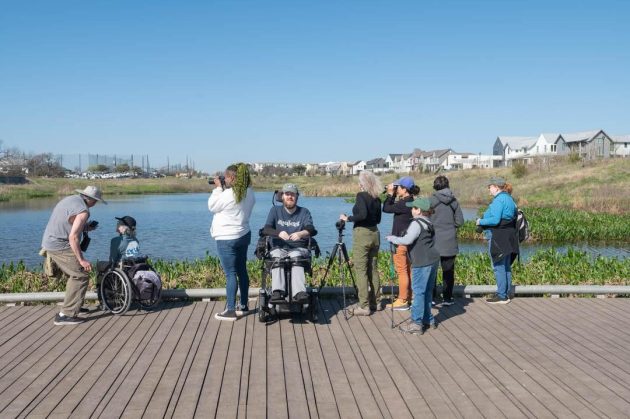
A Birdability Outing in spring 2024. Photo courtesy of Eric Clow, Birdability Captain. (image description: a group of birders with various mobility aids and using wheelchairs gather on a boardwalk on an early spring day. There is water behind them and several folks are using cameras or scopes to look at the wetlands for birds)
With that in mind, I want to share some simple, practical ways you can make birding more accessible. Whether you’re a group leader planning an outing, an organization setting up birding events, or a birder just wanting to create a welcoming space, these tips are for you. Accessibility doesn’t have to be complicated—it’s all about building an inclusive and supportive community. Let’s dive in!
1. Share Access Info Early and Often
Imagine showing up at a birding event and not knowing whether you’ll be able to access the trail or facilities. Yikes, right? Let’s take that anxiety away by sharing all the important details ahead of time. Is the trail paved or a natural surface? Are there restrooms? Benches? What about shade or shelter? The more information you provide, the better folks can decide if they want to and are able to participate. Bonus points if you include pictures and detailed descriptions! Access Considerations guidance is available on our website.
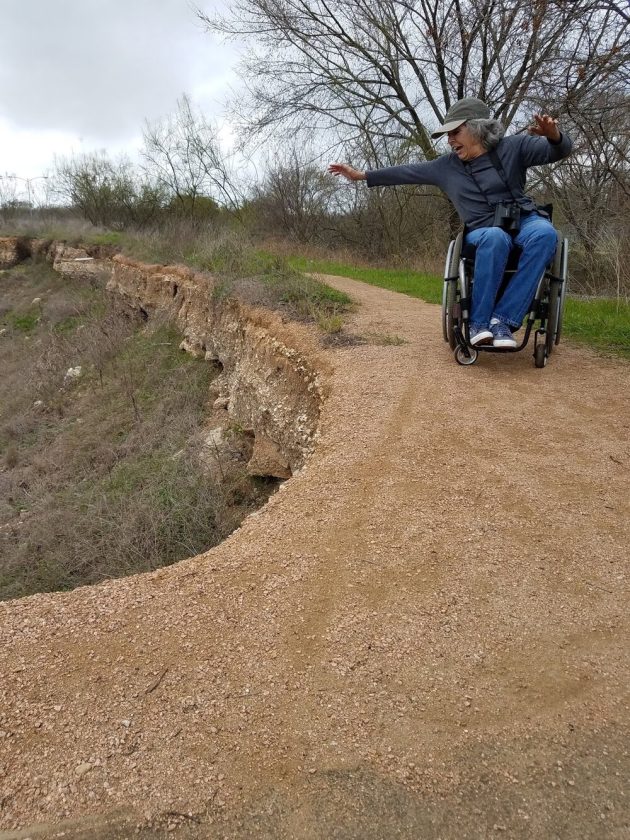
Virginia Rose, Founder of Birdability, on a trail she WISHED she had more information about ahead of time. From the Birdability Website. (image description: a white woman in a manual wheelchair feigns fear as she looks over the side of a stone and dirt trail with no barrier and a sharp drop off)
2. Partner Up with Local Disability Organizations
Why not work with disability organizations in your community? These groups have a wealth of knowledge, and they’re often eager to partner with birding events. They can help get the word out, offer advice on how to make your event more accessible, and even connect you with birders who might love to join. It’s a win-win, and it builds lasting community relationships!
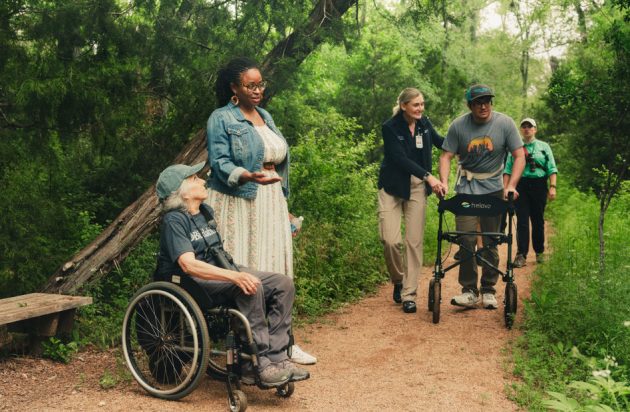
A local Rehabilitation Center was the ideal partner for an outing that Travis Audubon and Birdability organized at the new accessible Blair Woods Nature Preserve trail. Image by Mike Fernandez, National Audubon. (image description: a white woman in a manual wheelchair looks up at a walking Black woman next to her as they talk about birds. Coming toward them are a white man using a walker, and an occupational therapist helping him navigate the crushed, compacted rock trail)
3. Redefine What Birding Looks Like
Birding isn’t just one thing, and it shouldn’t look the same for everyone. If someone is blind, birding by ear is a beautiful way to experience the magic of birds. Deaf birders might use visual birding apps or focus on the vibrant colors and behavior of birds. Some folks prefer to bird as a mindfulness practice and not make lists at all, others are more interested in finding new kinds of birds to observe and love their lists! Birding should be flexible and open to everyone’s experience. Remember, it’s about enjoying nature however works best for YOU!

A group of blind and low-vision birders joined a Birdability Intern at Saugus Iron Works National Historic Site for a birding outing that focused on birding by ear and tactile exhibits. Photo courtesy of Environment for the Americas. (Image description: a group of 4 Black white cane users stand smiling at a national park site with a white man who is also low-vision standing to the far left in a khaki work shirt with his internship badge on it. There is also a white woman in a plaid coat who is acting as a sighted guide for one of the people using a white cane)
4. Offer Multiple Birding Options
Not everyone is up for a strenuous hike or a long day outdoors, and that’s okay! Try offering a variety of options—like stationary birding (sitting in a park or even a backyard setup), shorter, accessible trails, or virtual birding events. Giving people options makes birding more inclusive and helps everyone find something that works for their bodies and needs.
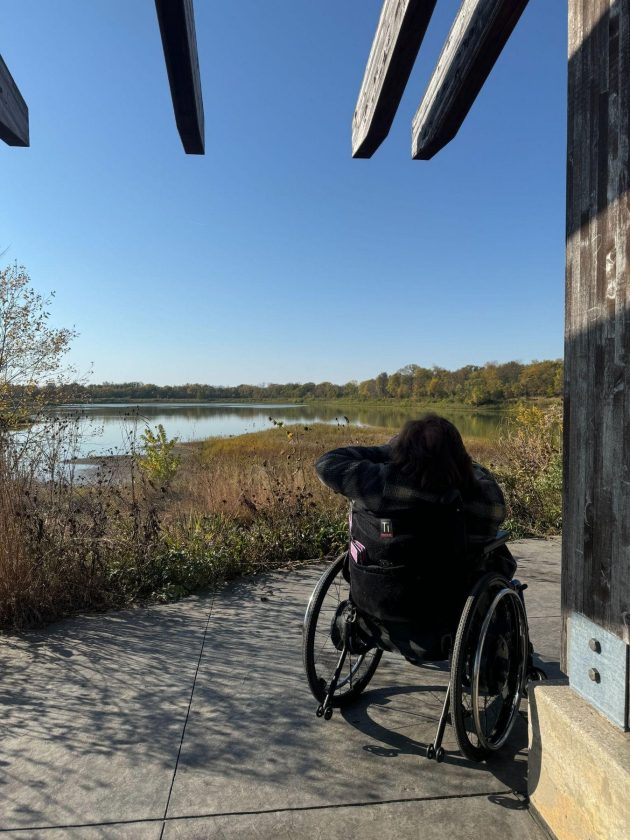
An accessible mindful birding event in Iowa City, IA. Paying deep attention to birds can happen anywhere. Photo courtesy of Birdability. (Image: a woman using a manual wheelchair has her back to the photo taker as she looks over a lake with a pair of binoculars. She is on a paved patio with large timber beams acting as a roof overhead and the foliage has turned brown and yellow with fall color)
5. Use Accessible Language and Visuals
When advertising your events or sharing updates, keep your language accessible. Avoid using overly technical terms, and be mindful of folks who may not know birding lingo. And, don’t forget to provide image descriptions for any photos you post online! This makes your content more inclusive for people who use screen readers or who benefit from extra visual context. We also like to remind folks that the term birding is far more inclusive than birdwatching, and bird outings include way more folks than birdwalk since not all of us can walk, so using that language whenever possible helps signify that your intent is access and inclusion!

(Image description: The image has a teal background with a small illustration of a gray and white bird in the top left corner. The text reads:”Birding vs Birdwatching The term birding is more inclusive when describing how people engage with and enjoy birds. Most birders don’t just look, but enjoy listening to birds too. More importantly, this language automatically includes birders who are blind or have low vision.” In the bottom right corner, the text “birdability.org” appears, indicating the source of the image)
6. Create a Welcoming Atmosphere
This one’s big, y’all. The most accessible trail or facility means nothing if folks don’t feel welcomed and included when they get there. Start with introductions and name tags (bonus points for pronouns!) so everyone knows each other. Foster a space where folks can speak up about what they need without judgment. We all deserve to feel like we belong, and that sense of belonging starts with community.
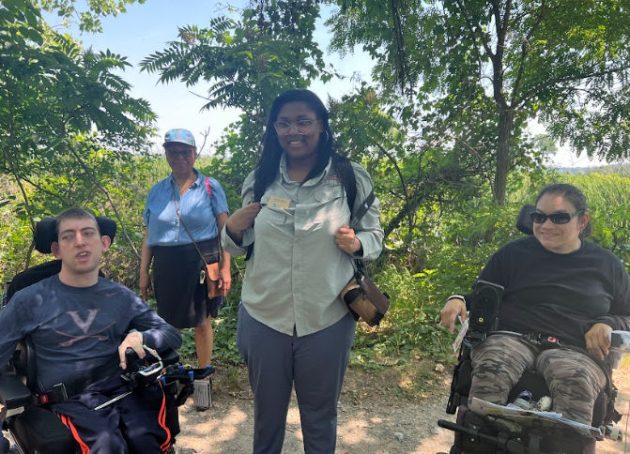
A bird outing at George Washington Memorial Parkway National Park Site led by a Birdability Intern featured ASL interpretation, opportunities for sensory play, and other welcoming activities. Photo courtesy of Environment for the Americas. (Image description: Four people are on a trail. A man using a power wheelchair is on the far left, with two Black women standing in between him and the other power wheelchair user on the right. They are all smiling at the camera with green trees in the background)
7. Stay Open to Feedback and Keep Learning
Birding events might not be perfect, and that’s okay! What’s important is that we listen to feedback, especially from folks with disabilities, and keep improving. Accessibility isn’t a one-and-done thing—it’s a continuous journey. So, keep your ears open, be flexible, and make adjustments when needed. Small changes can make a huge difference.
There you have it—7 ways to make birding more inclusive and accessible, simple and sweet! Birding is for everyone, and together, we can make it happen. Let’s create spaces where all birders feel welcome, valued, and excited to connect with nature. See you out there with the birds! If you haven’t yet, make plans to join us during Birdability Week for accessible outings, virtual events, and a Bird(ability) Your Way! A weekend full of birding in JUST the way that works for you.
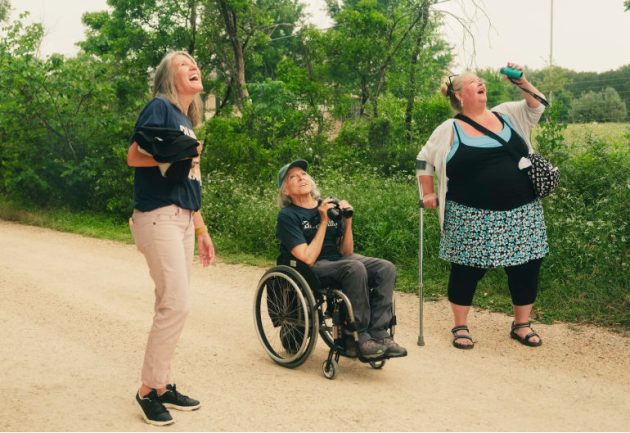
Cat, Virginia Rose, and AnneMarie from Travis Audubon observing and learning both the birds and how to be in community with folks with many different access needs at the Blair Woods Nature Preserve event. Photo courtesy of Mike Fernandez, National Audubon. (Image description: Three white women are on a gravel road, all looking up at the sky at a flock of Franklin’s Gulls going overhead.. The one on the far left is holding a stack of t-shirts, Virginia is in the middle using a manual wheelchair and a pair of binoculars, and Cat is on the right using her forearm crutch and a monocular)
Happy birding, Cat
Source link
Facebook
Pinterest
Twitter
LinkedIn

